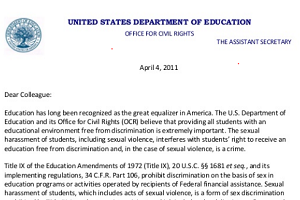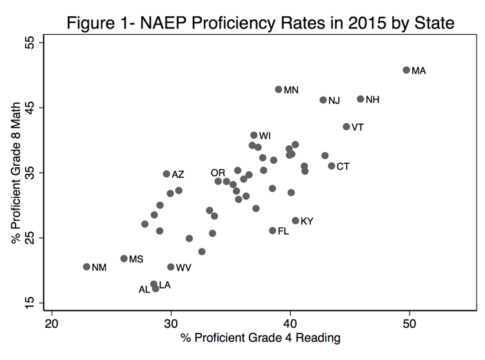
The U.S. Commission on Civil Rights recently released a 600+ page report on how thirteen federal agencies are enforcing civil rights laws. Like the Commission’s many previous reports, this one offers a grand tour through the extensive American civil rights state, describing the authority, responsibilities, structure, and operation of its numerous components. These include not just well known organizations as the Equal Employment Opportunity Commission, the Civil Rights Division of the Justice Department, and the Department of Education’s Office for Civil Rights, but also more obscure units such as the Office for Contract Compliance Programs in the Department of Labor, the Office for Civil Rights and Civil Liberties in Homeland Security, the Fair Housing and Equal Opportunity Office in the Department of Housing and Urban Development, and the variously named civil rights offices in Health and Human Services, the Veterans Administration, Interior, Agriculture, Treasury, and the Environmental Protection Agency. For those who must deal with any of these federal agencies, this is a valuable (if somewhat dry) source of information.
Are Rights a Reality? Evaluating Federal Civil Rights Enforcement is not just a source book on civil rights agencies, but also a heated and polemical attack on the Trump Administration. This has often been the case when the Commission releases a report during a Republican administration. Two facts have increased the level of hostility between the Commission and the White House: Donald Trump is president (what more need I say on this?); and the chair of the Commission, Catherine Lhamon, headed the Department of Education’s civil rights office during the Obama Administration. The Trump Administration has rescinded some of Lhamon’s signature initiatives, and she asked for testimony from some of the administration’s harshest critics. Given the Trump administration’s cavalier attitude toward the expertise of experienced civil servants and Congress’s failure to engage in serious oversight of regulatory programs, we should welcome such opportunities for extensive critical review of executive action.
Nonetheless, this report—like so many previous ones issued by the Commission—suffers from a basic flaw that substantially reduces its usefulness: it adopts an understanding of “enforcement” so broad and misguided that it swallows up all the controversial elements of civil rights policy. The report makes no distinction between key policy choices—for example, how to define “sexual harassment” under Title IX or the use of “disparate impact” analysis under Title VI to reduce school districts’ use of out-of-school discipline—and the strategies agencies use to induce schools and employers to comply with them. In fact, in the entire 600 pages, there is scarcely any mention of how these agencies write the rules and guidelines they then enforce. The underlying assumption is that “enforcing civil rights” means “enforcing the interpretation of civil rights statutes favored by the previous administration and a majority of the Commissioners.” “Better enforcement” means using aggressive measures to force employers and recipients of federal funds to comply with the broadest possible reading of statutory language.
If this seems like hyperbole, consider what the report says about discrimination based on sexual orientation and gender identity (which it referred to as “SOGI”). Relying on studies issued the Center for American Progress and ProPublica, the report decries the Trump Administration’s refusal to take corrective action in most “SOGI-related complaints.” The reason for that should be clear: the administration withdrew the SOGI guidance issued a few years before by the Obama Administration. In other words, the central issue is the substance of agency rules, not enforcement levels.
The Commission’s report tacitly assumes that the Obama Administration’s rules were demanded by Titles VI and VII of the Civil Rights Act. But only two years previously the Commission—with the same membership—insisted that protecting employees from these forms of discrimination required additional legislative action. The subtitle of that 2017 report was “Time for Congress to Enact Legislation to Address Workplace Discrimination Against Gay, Lesbian, Bisexual, and Transgender Americans.” It noted that “Over the past forty years, Congress has introduced multiple iterations of legislation that would prohibit workplace discrimination against LGBT Americans, but has not passed such legislation.” Until 2014, President Obama, too, insisted that prohibiting such discrimination in schools and employment required new legislation. When it became clear that Congress would not enact the bill favored by the Obama administration, the Education Department’s Office for Civil Rights issued a “Dear Colleague Letter” claiming that Title IX’s ban on “sex” discrimination included discrimination based on sexual orientation and gender identity. We can argue about the merits and the legality of that move, but presenting this as an “enforcement” matter seriously distorts the central issue.
So completely does the report sweep everything these agencies do into the category of “enforcement,” that it says almost nothing about how they establish the thousands of pages of rules, guidelines, and technical guidance they expect everyone to follow. When I testified before the Commission in November 2019, I criticized the Education Department’s Office for Civil Rights for relying entirely on unilaterally “Dear Colleague Letters” and evading the rulemaking procedures required by the Administrative Procedure Act. This was hardly a novel complaint: a few years previously two U.S. Senators had admonished Assistant Secretary of Education for Civil Rights Catherine Lhamon for her agency’s failure to follow this act. The 2019 report briefly noted this criticism, responding only with a non-sequitur: “the United Supreme Court has issued a unanimous and dispositive ruling on the question, which determined that agencies do have authority to issue policy guidance.” Of course they do. But that is not the question. The problem is that the Education Department’s Office for Civil Rights has repeatedly used a truncated process that limits public participation and information gathering when it makes key policy choices. It then insists that those subject to regulation comply with this “guidance” or face severe consequences.
In 2014 Senator Lamar Alexander pressed then-Assistant Secretary Lhamon on the status of Office for Civil Rights guidance documents and her agency’s repeated refusal to use the notice-and-comment rulemaking procedures required by the Administrative Procedure Act. When asked whether she “expects institutions to comply with your title IX guidance documents,” she answered unequivocally: “Yes we do.” When asked why the formulation of these federal mandates does not require the use of standard rulemaking procedures, she replied, “We would if there were regulatory changes.” Why did the lengthy, detailed, and controversial rules the Office for Civil Rights had issued on sexual harassment in 2010 and 2014 did not constitute “regulatory changes”? Because, Lhamon responded, “That is actually what the law is, and its guidance about the way we enforce.” In other words, she was claiming, there were no policy choices involved here, or in the hundreds of other pages of Office for Civil Rights guidance issued under Titles IX in the preceding decades. All these detailed requirements were simply deductions from the statute’s 39-word prohibition of sex discrimination.
This is an absurd and disingenuous claim, as anyone who has read these guidance documents well knows—to say nothing of those who have faced the difficult job of writing them or complying with them. But it helps us understand the central conceit of this and many previous Commission reports. Under the view expressed by the report, the rules enforced by civil rights agencies and courts are not the result of policy choices that should be explained and debated in public or subject to revocation by subsequent administrations. Rather, they are the product of administrator’s progressively evolving understanding of what statutory and constitutional rights mean. And this evolution proceeds in only one direction: toward a more expansive understanding of nondiscrimination rights—no backsliding. Law professors call this “dynamic interpretation.” Those subject to this growing body of rules often call it administrative aggrandizement. The Commission just calls it “enforcement.”
What we most want to know about civil rights enforcement is how effective it has been in reducing various forms of discrimination. Unfortunately, the report does not tell us anything about that, and for a very good reason: we have no reliable way of measuring what we most want to know. The report correctly notes that “civil rights offices do not use a standard metric to measure efficacy.” The chapters on particular agencies describe the measures each uses to evaluate how well it is doing. Most count up how many complaints they have resolved in a timely manner. Some try to give more weight to bigger cases. Such measures help us understand how agency personnel spend their time. But they tell us almost nothing about the effect of these activities on the real world. That is not the agencies’ fault. The sad fact is that we just don’t know how to do it.
The report correctly notes that the way most civil rights agencies try to measure their effectiveness has allowed the Trump administration (like the administrations of Ronald Reagan, George H.W. Bush, and George W. Bush) to tout their effectiveness by closing cases quickly—which usually means with a finding of no violation. There is a deep irony here. By placing so much weight on enforcement rather than policymaking, the Commissioners and their allies in advocacy groups have unintentionally made enforcement statistics the chief battleground. However dubious complaint-resolution numbers may be, they provide a politically cogent Republican response to the Democrats’ insufficient-enforcement critique.
The strangest feature of the Commission’s report is that it devotes more than 600 pages to describing the policies of civil rights agencies yet ignores the controversies that have engulfed these agencies for decades. How do we define that key word, “discrimination”? Must administrators and judges find “disparate treatment,” or is a showing of “disparate impact” sufficient? How do we know when a school district has become “unitary,” and thus can be released from a desegregation order? Should school districts be allowed to assign students to particular schools on the basis of their race in order to promote racial integration? Does “discrimination on the basis of sex” include discrimination on the basis of gender identity? When does sexual misconduct by individual students become “sex discrimination” by an educational institution? What form of language instruction is sufficient to demonstrate that a school has not discriminated on the basis of “national origin”? What constitutes an “appropriate education” for students with severe disabilities? The report is silent on these matters because it assumes—contrary to everything we all know—that they have been resolved by the statutes enacted by Congress.
The Commission’s staff is to be commended for compiling so much data on civil rights agencies. But in the end the reader is left wandering among the trees, without any guidance on the contours or the significance of the forest. One cannot hope to understand or evaluate the enforcement activities of federal agencies without understanding and evaluating the substance of the rules and regulations they are enforcing. But that would open up political questions the Commission seems intent upon avoiding.
R. Shep Melnick is Thomas P. O’Neill, Jr., Professor of American Politics at Boston College.




